 |
| Princess Mary |
Marriage in Mind
Anne Boleyn supported the idea of her cousin Henry marrying Princess
Mary; Anne may have thought that the marriage would dilute Mary’s threat to any
children Anne might have if and when she married the king.
In the summer of 1529 rumours of the proposed marriage were circulating through the court to the
effect that Norfolk was trying to push the marriage through. This may also be
correct, as having a Howard married to Henry VIII’s heir would place the family
in a very powerful position. And that, taken with Anne’s position as queen in
waiting would make Norfolk almost unassailable.
In October
1529 Chapuys reported to his master;
‘This king is so blindly and
passionately fond of his Anne that he has, at her persuasion, consented to
treat of a marriage between the Princess Mary his daughter, and the son of the
Duke of Norfolk.’[i]
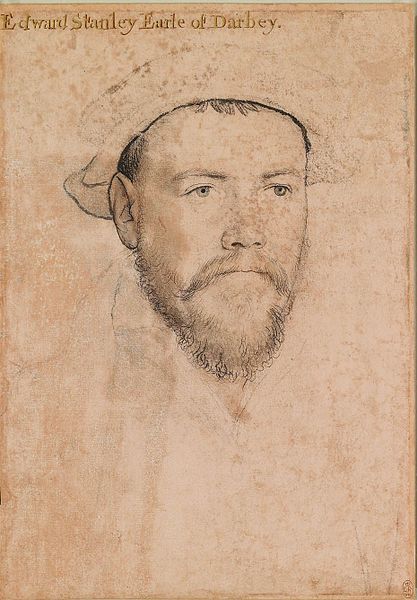 |
| Edward Stanley, Earl of Derby |
But shortly
thereafter Anne changed her mind; she had come to understand that Norfolk would
put the good of the family above her needs, a prophetic insight into her
uncle’s mind. She now stood between an alliance that would benefit the Howards
but do nothing for her.
In 1530
Norfolk arranged a marriage between his younger son Thomas and his ward
Elizabeth Marney, heir to John, Lord Marney. The couple wed in 1533 when Thomas
was thirteen. On 21st February 1530 Norfolk, having married his
eldest daughter Katherine to the under-age Edward Stanley, Earl of Derby, was obliged to seek the king’s pardon;
‘For the abduction of Edward
Earl of Derby and [his] marriage to Katherine daughter of the said Thomas
without royal licence.’[ii]
It was only
a few weeks thereafter that Chapuys was informing his royal master that Lady
Katherine had died suddenly of the plague. To ensure that the Stanley
connection not be lost to the Howard family, Thomas arranged for Derby to marry
his half-sister Dorothy Howard.
Marriage Contracts
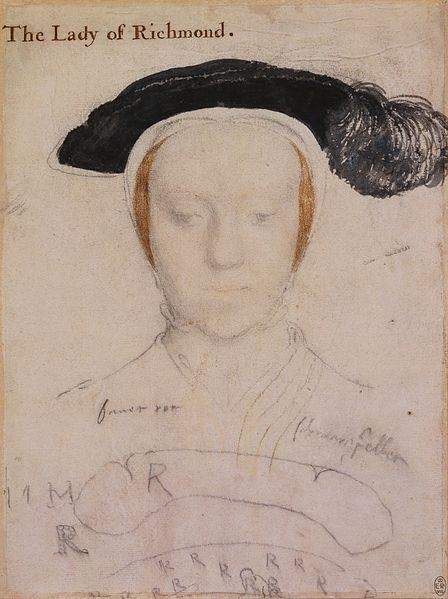 |
| Mary Howard |
Despite her
opposition to the marriage between Mary Tudor and Henry, Anne was prepared to
press Henry VIII for a marriage between Fitzroy and Henry’s sister Mary. The
king’s agreement to this marriage of his beloved son was finagled by Anne
Boleyn. That the Howards were not required to provide a dowry for Mary
indicates the strength of Henry VIII’s love for Anne. Later Norfolk was to
claim;
‘The marriage was made by
his [the king’s] commandment, without that I ever made suit therefor, or yet
thought thereon, being fully concluded then with my Lord of Oxford[iii].’[iv]
Mary’s
mother preferred the Oxford alliance but her wishes were overruled by Anne. The
marriage agreement was finalised in the spring of 1531 and the formal
engagement was to take place in June 1533 when Fitzroy was thirteen.
In lieu of
Henry’s proposed marriage to the Princess and, possibly, to make up for the
loss of Mary to Fitzroy, in April 1532 Norfolk agreed to a marriage between his
eldest son and Frances Vere, daughter of Earl of Oxford. Chapuys
was not impressed with Norfolk’s choice of daughter-in-law;
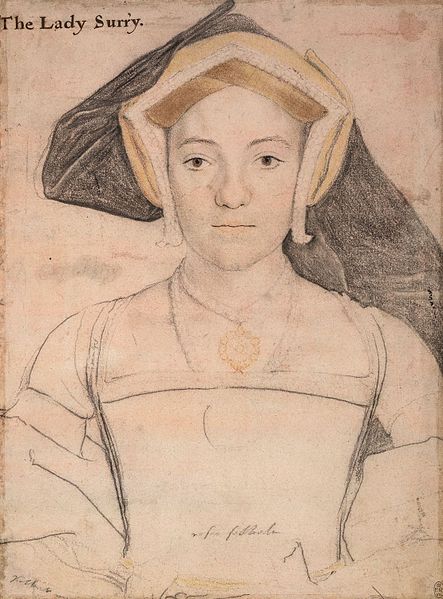 |
| Frances Vere |
‘The Duke must have had very
urgent reasons for acting thus[v]…..the
Lady is neither rich nor a very desirable alliance otherwise.’[vi]
In January
Norfolk endowed Henry with £300 per annum[vii]
while Oxford settled four thousand marks[viii]
on his daughter. This princely sum was to be paid in instalments of two hundred
marks on the day of the marriage and the remainder in six monthly sums of one
hundred marks. Each father was to provide for his child’s personal clothing;
the marriage took place in 1535 or 6 at Kenninghall. The young couple were
deemed too young to be setting up a household and the bride returned home with
her parents while Henry went back to Windsor. Before this happened the young
couple sat for Hans Holbein who drew their portraits.
The great
divorce too was taking longer than expected. A new mission had been sent to
Rome in 1531, the matters to be covered had been agreed by the king, Stephen Gardiner, the Lord Chancellor and Bishop of Winchester, and Norfolk. By 1532 Parliament,
under Cromwell’s management, was developing a bias
against Rome. The king was also activating intellectual support for his
position on the abuses of the church. Sadly none of this procured the desired effect.
A French Adventure
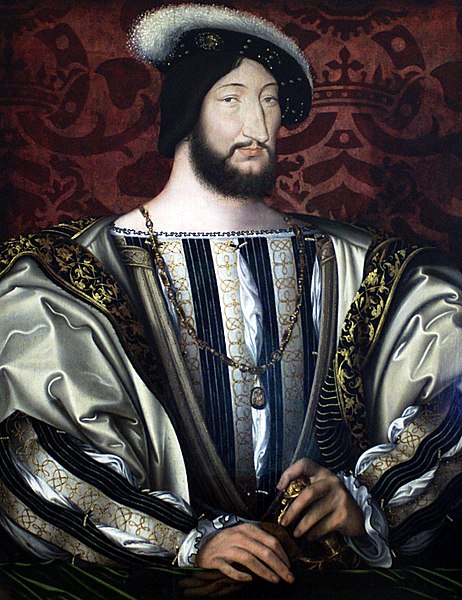 |
| Francois I |
In October
1532 Henry and Fitzroy accompanied the king on a trip across the Channel to France[ix].
Also at the king’s side was his paramour and over three thousand nobles,
knights, pages and servants who travelled in the king’s train. It took only
five hours before the walls of Calais were sighted.
Henry was
here to meet François I, the two kings met at Boulogne and Henry was in the party that rode there on 21st
October. The get-together lasted four days and then the two kings rode to
Calais to continue the summit.
Throughout
the visit to the Calais Pale Henry VIII did his best to outdo the
French hospitality[x],
spending £6,000[xi]
on the visit. On 27th October there was bull and bear baiting, which must
have pleased Henry and Fitzroy. It was followed by a banquet of one hundred and
seventy dishes; the Venetian ambassador, who had not been invited to the party,
sniffed at the expense.
‘A
superfluous expenditure – entertainments, pageants and nothing else.’[xii]
He was wrong; the two kings agreed an alliance against the infidel Turk
while two French cardinals were to leave immediately for Rome to press for
Henry VIII’s divorce from his queen. It was also planned that François would
arrange to meet Pope Clement somewhere in France with an English representative[xiii] (possibly Norfolk whose
pension from the French had just been raised to three thousand crowns[xiv]).
Henry VIII’s gratitude was such that he wrote off the debt the French
owed him for the ransom of François’ sons who had been taken hostage after the
French defeat at the Battle
of Pavia[xv]. In
return Fitzroy and Henry were to live at François’ court, an extension of their
visit that certainly surprised Fitzroy as he spent his last day in Calais
hastily arranging for the disposition of his servants left in England.
To Paris
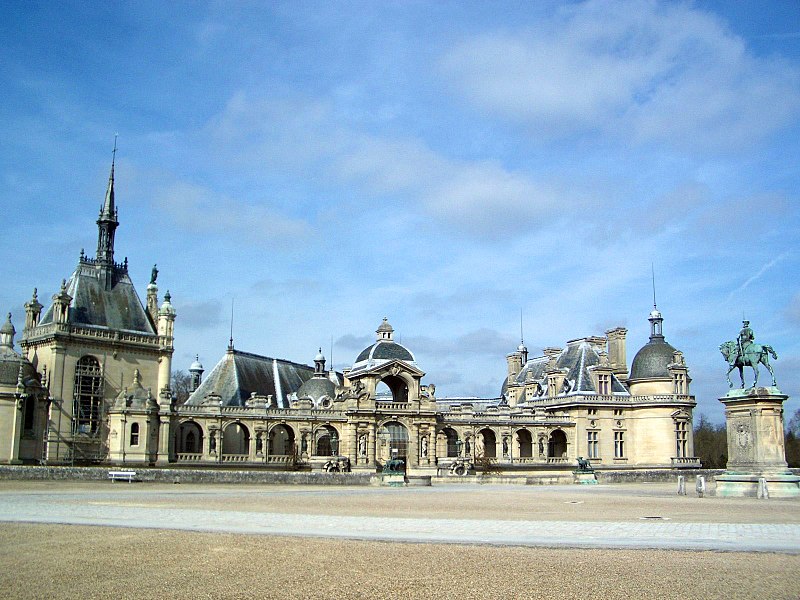 |
| Chateau of Chantilly |
In November
1532, while still in Calais[xvi],
Henry contracted a fever which was to hang around for about a month. He was
well enough to travel after a few days. He and Fitzroy were accompanied by
sixty servants on the journey. Fitzroy’s almoner Richard Tate, reporting back to England, wrote;
‘My Lord of Richmond and my
Lord of Surrey in all their journey towards the French court hath been very
well welcomed and in all places have had presents of wines with other gentle
offers.’[xvii]
François and his court started the return
journey in advance of the king’s young guests and Henry and Fitzroy caught up
with the court at Chantilly at the end of the month. The two
young men were greeted with pleasure by François. A few days later the court moved on to Paris where Henry and Fitzroy were put up in the Dauphin’s lodgings in the Louvre Palace.
The French
court was a licentious place where Henry VIII would not have felt out of place.
But it was not only licentiousness that the court was renowned for; François
was erudite and a man of letters and set up one of the greatest libraries in
Europe. A generous patron to the like of the Humanist Guillaume Budé, François attracted refugee
academics from Italy after the fall of the Republic of Florence, including the poet Luigi Alamanni. He must have been an inspiration for Henry who was more
academic than Fitzroy.
Bibliography
Henry VIII’s
Last Victim – Jessie Childs, Vintage Books 2008
The Ebbs and
Flows of Fortune – David M Head, University of Georgia Press 2009
House of
Treason – Robert Hutchinson, Phoenix 2009
Henry VIII –
Robert Lacey, Weidenfeld & Nicholson & Book Club Associates 1972
The Earlier
Tudors – J D Mackie, Oxford University Press 1992
Bastard
Prince – Beverley A Murphy, Sutton Publishing 2001
Rivals in
Power – David Starkey, MacMillan London Ltd 1990
The Six
Wives of Henry VIII – Alison Weir, Pimlico 1992
www.wikipedia.en
[i]
Henry VIII’s Last Victim - Childs
[ii]
Bastard Prince - Murphy
[iv]
Bastard Prince - Murphy
[v]
It has been suggested that Anne had realised that a marriage between Henry and
Princess Mary would mean the loss of her uncle’s support for her own wedding.
She was fast becoming very unpopular with the English who supported their
Spanish queen
[vi]
Henry VIII’s Last Victim - Childs
[vii]
In 2015 the relative: historic standard of
living
value of that income or wealth is £162,100.00 labour earnings of that income or wealth is
£2,027,000.00 economic status value of that income or wealth is £5,653,000.00 economic power value of that income or
wealth is £77,950,000.00 www.measuringworth.com
[viii] In 2015 the
relative: historic standard of living value of that income or wealth is £2,161,000.00 labour earnings of that income or wealth is £27,030,000.00 economic status value of that income or wealth is £75,370,000.00 economic power value of that income or wealth is £1,039,000,000.00 www.measuringworth.com
[ix]
Norfolk was already over in France acting as Henry VIII’s agent making the
arrangements for the summit
[xi]
In 2015 the relative: labour cost of that project is
£40,540,000.00 economic cost of that project is £1,559,000,000.00 www.measuringworth.com
[xii]
Henry VIII’s Last Victim - Childs
[xiii]
The meeting was made moot by Anne’s pregnancy in December see http://wolfgang20.blogspot.co.uk/2015/02/the-importance-of-being-thomas-vi.html
[xiv]
In 2015 the relative: historic standard of
living
value of that income or wealth is £324,200.00 labour earnings of that income or wealth is
£4,054,000.00 economic status value of that income or wealth is £11,310,000.00 economic power value of that income or
wealth is £155,900,000.00 www.measuringworth.com
[xvi]
The wind was in the wrong direction for Henry VIII to return home
[xvii]
Henry VIII’s Last Victim - Childs
No comments:
Post a Comment
Note: only a member of this blog may post a comment.